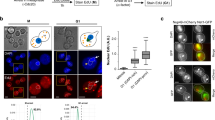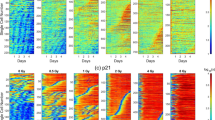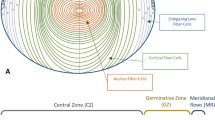Abstract
PREVIOUS experiments have shown that a penetrating needle injury to the central area of rabbit lens epithelium in vivo produces a response in which a large number of cells synthesize DNA and divide1. This response begins characteristically at the site of injury and progresses farther and farther away from the wound with time. Experiments have indicated that DNA synthesis is initiated in the cells closest to the wound at about 12–14 h after injury2. Mitosis is first seen at about 24 h after injury. The rate at which the wave of DNA synthesis travels was calculated to be about 17 µ/h. The typical picture obtained at 48 h after injury shows a band of cells which are synthesizing DNA and completely encircle the wound. Another band of mitotic figures is seen encircling the wound and lying between the DNA synthesis band and the injury but close to the DNA synthesis band. Frequently, when the injuries are larger (these can be obtained by using a larger needle) a ‘second wave’ of DNA synthesis and mitosis can be seen.
This is a preview of subscription content, access via your institution
Access options
Subscribe to this journal
Receive 51 print issues and online access
$199.00 per year
only $3.90 per issue
Buy this article
- Purchase on Springer Link
- Instant access to full article PDF
Prices may be subject to local taxes which are calculated during checkout
Similar content being viewed by others
References
Harding, C. V., Donn, A., and Srinivasan, B. D., Exp. Cell Res., 18, 582 (1959).
Harding, C. V., Feldherr, C., and Srinivasan, B. D., in The Structure of the Eye, edit. by Smelser, G. K., 273 (Academic Press, New York, 1961).
Taylor, J. H., Woods, P. S., and Hughes, W. L., Proc. U.S. Nat. Acad. Sci., 43, 122 (1957).
Srinivasan, B. D., and Harding, C. V., Stain Technol., 38, 283 (1963).
Gelfant, S., Exp. Cell Res., 26, 395 (1962).
Taylor, J. H., in Molecular Genetics, edit. by Taylor, J. H., Part 1, 65 (Academic Press, New York, 1963).
Harding, C. V., and Srinivasan, B. D., Exp. Cell Res., 25, 326 (1961).
Maenza, R. M., and Harding, C. V., Nature, 196, 786 (1962).
Thomson, D. S., Pirie, A., and Overall, M., Arch. Ophth., 67, 464 (1962).
Mikulicich, A. G., and Young, R. W., Invest. Ophthal., 2, 344 (1963).
Author information
Authors and Affiliations
Rights and permissions
About this article
Cite this article
SRINIVASAN, B. Chromosome Duplication and the Cell Cycle in Lens Epithelium. Nature 203, 100–101 (1964). https://doi.org/10.1038/203100b0
Published:
Issue Date:
DOI: https://doi.org/10.1038/203100b0
Comments
By submitting a comment you agree to abide by our Terms and Community Guidelines. If you find something abusive or that does not comply with our terms or guidelines please flag it as inappropriate.



